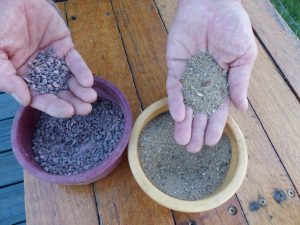Some chicken keepers may be secret arenophiles! They lug sand into the coop and use it for bedding. Is that a good thing?
The word “arenophile” is a blend of Greek and Latin tracing back to ancient Rome.
In those days crowds gathered in huge arenas to watch gladiators fight to a gory death.
Before bouts workers covered the arena’s surface with a thick layer of sand to absorb blood. Gross!
Fortunately, those violent days are gone. Today the word “arenophile” generally means someone who collects samples of sand from such far-flung places as the beaches of Tahiti or Normandy. Others may come from coral reefs or vast deserts. It can be a fascinating hobby, since sand is so variable and beautiful. It is simply tiny grains that can originate from broken pieces of shells or many types of rock. By far the most common is quartz sand, composed of the earth’s most abundant elements – silicon and oxygen. Varied sands make fascinating displays, but does this humble material have a place in chicken care?
Absorbency is important for chickens. Materials placed on the ground or floor inside and outside coops should absorb water or channel it downward, reducing odor and keeping hens healthy.
Sand works wonderfully in outside runs. It filters rain down into the soil beneath it. A dirt run compacted by thousands of chicken footsteps doesn’t shed rain well. Puddles form, promoting disease. In contrast, a sandy run quickly dries following downpours and won’t form muddy puddles.
Sand also boosts chicken digestion. A bit of coarse quartz sand in a hen’s gizzard helps her grind coarse seeds into a slurry that passes into her stomach for digestion. Chickens need grit, and coarse quartz sand is perfect. Come winter’s chill, when the ground is frozen, hens appreciate a handful of sand sprinkled on the indoor litter. Every once in a while, they’ll swallow a few grains to help the gizzard grind hard seeds when outdoor grit is frozen and unavailable.
A coop’s interior is a different story. Rain never hits material on the floor, called litter. Wood flakes, ground corn cobs, or other coarse organic fibery materials all work perfectly inside to absorb moisture from droppings. It lasts for months, looks and smells great, and when removed can be composted into a perfect garden soil additive. A blend of decomposed chicken manure and wood fibers encourages vegetables to jump from the soil and yields delicious crops of tomatoes, beans, and other summer delicacies.
Sand is a poor interior litter. It’s heavy, doesn’t absorb as well as wood flakes, and is less useful in the garden when shoveled out of the coop. But it shines outside.

Using Sand
Do you have heavy, compacted soil in the chicken run? Do puddles form after rain? Sand can solve both problems. Spreading an inch, or so, of sand on the compacted soil gives the hens a chance to gradually scratch it into the dirt. The result will be more porous soil that lets water drain through it. Filling a puddle with sand also prevents breeding mosquitoes while creating a pleasant walking surface for hens.
Thousands of kinds of sand can be collected or bought, but there’s good news for chicken keepers. The least expensive sand sold at home supply stores is usually marketed as traction sand and sold to sprinkle on icy sidewalks. It usually has grains of varied size and works perfectly in the run. More expensive play sand or concrete grade sand also work but costs more. Sharp edged grit sold in farm stores is basically human made sand. It works perfectly when used to fill run puddles and is ideal for chicken digestion but is pricier than plain old traction sand.
So, perhaps it’s good for chicken keepers to be arenophiles and use sand to help manage the flock.